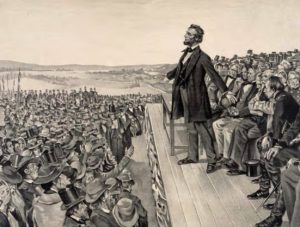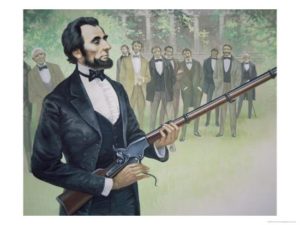 Most people know what Lincoln was doing on November 19, 1863 because they had to memorize the Gettysburg Address in school. But the rest of the day itself is less known. Looking at The Lincoln Log, which is an expanded online version of a book called “Lincoln Day-by-Day,” provides some fascinating detail. Keep in mind that Lincoln arrived in Gettysburg the evening before, taking time to touch up the final passages at David Wills’s house on the square in downtown Gettysburg. The following is what he did almost hour by hour on November 19th, according to The Lincoln Log (the sources are listed at the end of each entry):
Most people know what Lincoln was doing on November 19, 1863 because they had to memorize the Gettysburg Address in school. But the rest of the day itself is less known. Looking at The Lincoln Log, which is an expanded online version of a book called “Lincoln Day-by-Day,” provides some fascinating detail. Keep in mind that Lincoln arrived in Gettysburg the evening before, taking time to touch up the final passages at David Wills’s house on the square in downtown Gettysburg. The following is what he did almost hour by hour on November 19th, according to The Lincoln Log (the sources are listed at the end of each entry):
Thursday, November 19, 1863.
Gettysburg, PA and Washington, DC.
According to Nicolay’s account, after breakfast at Wills house, Lincoln retires to his room, where Nicolay joins him, and completes preparation of his speech. John G. Nicolay, “Lincoln’s Gettysburg Address,” The Century Magazine 25:598.
About 10 A.M. President, dressed in black, wearing white gauntlets and usual crepe around hat in memory of Willie, leaves Wills house to join procession. Receives round after round of “three hearty cheers,” and shakes many hands as crowd gathers. Washington Chronicle, 21 November 1863.
Thousands welcome President in Gettysburg. Weather fine. Flags in Washington at half-mast in honor of dead in cemetery at Gettysburg. Evening Star (Washington, DC), 19 November 1863, 2d ed., 2:6.
Gov. Curtin (Pa.), who arrived last evening with numerous important people on special train from Harrisburg, Pa., remarks to Lincoln about serenade given Gov. Seymour (N.Y.), and Lincoln replies: “He deserves it. No man has shown greater interest and promptness in his cooperation with us.” Rice, 514.
President mounts “a magnificent chestnut charger.” Monaghan, Diplomat, 341.
Rides in procession to cemetery. Hay, Letters and Diary.
Procession delayed; starts to move about 11 A.M. LL, No. 1425.
Head of procession arrives at speaker’s platform inside cemetery at 11:15 A.M. President receives military salute. President and members of cabinet, with group of military and civic dignitaries, occupy platform. “The President was received with marked respect and a perfect silence due to the solemnity of the occasion, every man among the immense gathering uncovering at his appearance.” Washington Chronicle, 20 November 1863.
Lincoln shakes hands with Gov. Tod (Ohio), who introduces Gov.-elect John Brough (Ohio), and takes his place between chairs reserved for Sec. Seward and Edward Everett, orator to make principal address. At 11:40 A.M. Everett arrives, is introduced to President, and program music begins. Washington Chronicle, 21 November 1863.
Once during Everett’s two-hour oration Lincoln stirs in his chair. “He took out his steel-bowed spectacles, put them on his nose, took two pages of manuscript from his pocket, looked them over and put them back.” Monaghan, Diplomat, 341.
About 2 P.M. Lincoln “in a fine, free way, with more grace than is his wont” delivers Gettysburg Address. He holds manuscript but does not appear to read from it. John G. Nicolay, “Lincoln’s Gettysburg Address,” The Century Magazine 25:602; Dennett, Hay Diaries and Letters, 121; Address Delivered at the Dedication of the Cemetery at Gettysburg, 19 November 1863, CW, 7:22-23.
Pronounces his “r” plainly, does not speak like Southerner. Henry B. Rankin, Intimate Character Sketches of Abraham Lincoln (Philadelphia: Lippincott, 1924), 285.
On platform, after speech, President remarks to Marshal Lamon: “Lamon, that speech won’t scour! It is a flat failure and the people are disappointed.” Lamon, Recollections, 173.
John R. Young, recording speech in shorthand for Philadelphia “Press,” leans across aisle and asks President if that is all. Lincoln replies, “Yes, for the present.” John R. Young, Men and Memories: Personal Reminiscences, 2 vols., edited by May D. Russell Young (New York: F. T. Neely, 1901), 1:69.
President decides to hear address by Lt. Gov.-elect Charles Anderson (Pa.) at 4:30 P.M. in Presbyterian Church. Meets “old John Burns, the soldier of 1812, and the only man in Gettysburg who volunteered to defend it.” Burns accompanies him and Sec. Seward to hear Anderson speak. President’s special train leaves Gettysburg about 7 P.M. and arrives in Washington at 1:10 A.M. on Friday. Washington Chronicle, 21 November 1863.
Lincoln returns from Gettysburg with a mild form of smallpox (varioloid) and remains under half quarantine in White House for nearly three weeks. Bates, Diary, 30 November 1863; Welles, Diary, Dec.
David J. Kent is President of the Lincoln Group of DC and the author of Lincoln: The Man Who Saved America, in Barnes and Noble stores now. His previous books include Tesla: The Wizard of Electricity and Edison: The Inventor of the Modern World and two specialty e-books: Nikola Tesla: Renewable Energy Ahead of Its Time and Abraham Lincoln and Nikola Tesla: Connected by Fate.
Check out my Goodreads author page. While you’re at it, “Like” my Facebook author page for more updates!



 Lincoln took a scientific approach to military strategy. The Anaconda plan’s focus was on securing the coastlines and the Mississippi River. Recognizing New Orleans as the hub of the cotton trade and commerce, Lincoln saw it as the first port to be targeted for blockade. He also hoped to block southern ship traffic from Charleston, South Carolina to cut off Confederate attempts to woo Great Britain and France to their side. Helping him make this happen was Alexander Dallas Bache and the Coast Survey. The Coast Survey had been authorized by Thomas Jefferson, and Bache, who was Benjamin Franklin’s great-grandson, was quick to send nautical charts of the Chesapeake Bay to Lincoln. He also forwarded two terrestrial maps produced by the Survey that had far-reaching influence on Lincoln’s decisions on emancipation and military strategy.
Lincoln took a scientific approach to military strategy. The Anaconda plan’s focus was on securing the coastlines and the Mississippi River. Recognizing New Orleans as the hub of the cotton trade and commerce, Lincoln saw it as the first port to be targeted for blockade. He also hoped to block southern ship traffic from Charleston, South Carolina to cut off Confederate attempts to woo Great Britain and France to their side. Helping him make this happen was Alexander Dallas Bache and the Coast Survey. The Coast Survey had been authorized by Thomas Jefferson, and Bache, who was Benjamin Franklin’s great-grandson, was quick to send nautical charts of the Chesapeake Bay to Lincoln. He also forwarded two terrestrial maps produced by the Survey that had far-reaching influence on Lincoln’s decisions on emancipation and military strategy. Abraham Lincoln spoke these words in a speech generally referred to as the
Abraham Lincoln spoke these words in a speech generally referred to as the 







